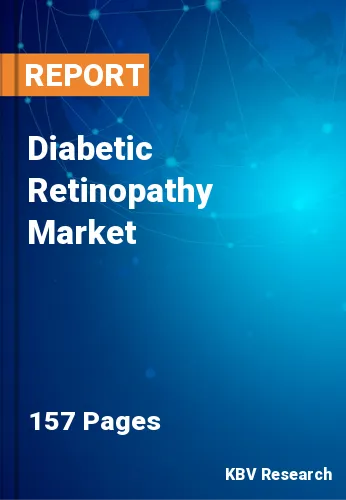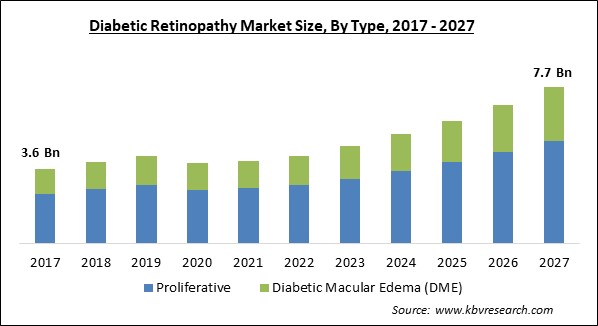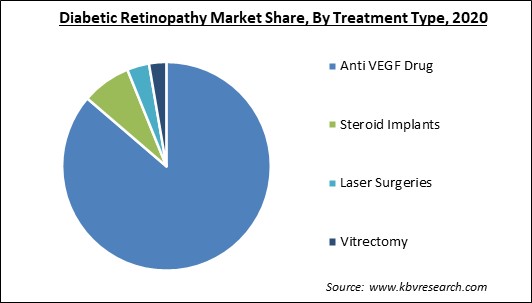
The Global Diabetic Retinopathy Market size is expected to reach $7.7 billion by 2027, rising at a market growth of 11.3% CAGR during the forecast period.
Diabetic retinopathy is a critical medical disorder that affects the eyes as a result of diabetes or inefficient insulin level in the blood of the patient. Impairment to blood vessels of the light-sensitive tissue of the retina is the main cause of diabetic retinopathy. In addition, blurred vision, dark or empty spots in the vision, fluctuating vision, poor color identification, and vision loss are the most typical symptoms of this disorder. A high sugar level in the blood causes blockage of the retina's small blood capillaries, impeding blood flow. Advanced cases of diabetic retinopathy require laser therapy or surgical operations. Mild-to-moderate instances of diabetic retinopathy can be cured with appropriate diabetes management.
Diabetic retinopathy may cause no symptoms or just minor vision abnormalities in the initial stages, however, it can result in blindness in advance stages. Anyone with type 1 or type 2 diabetes can develop the illness. The longer a person has diabetes, the more likely they are to develop ocular complications due to poorly regulated blood sugar levels. Diabetic retinopathy can progress to diabetic retinal detachment, macular edema, and neovascular glaucoma, among other serious eye disorders.
Diabetic retinopathy can also mutate to proliferative diabetic retinopathy, which is a more severe form of the disorder. Affected blood vessels close off in this type, leading the retina to develop new, dysfunctional blood vessels. These new blood vessels are fragile, and they may leak into the clear, jellylike fluid that fills the center of the eye of the patient. Non-proliferative diabetic retinopathy, NPDR, is a kind of diabetic retinopathy in which symptoms are minimal or absent. New blood vessels are weakened or stop forming in this more prevalent form of diabetic retinopathy. The membranes of the blood vessels in the retina deteriorate when a patient suffers NPDR. Small bulges emerge from the smaller vessels' walls, occasionally blood and seeping fluid into the retina. Larger retinal vessels may also begin to dilate and their size becomes irregular.

The COVID-19 pandemic caused a severe impact to various economies all over the world. Several businesses were significantly devastated as a result of the outbreak of the COVID-19 infection. In addition, the governments of several countries were forced to impose lockdowns in their nations. As a result, the manufacturing units of numerous goods were temporarily shut. Moreover, these lockdowns also caused a major disruption in the supply chain of various goods. Further, the COVID-19 led the worldwide healthcare industry to a significant failure due to the shortage of beds and oxygen in hospitals. The outbreak of COVID-19 all over the world has placed healthcare workflows in a disarray. Various industries, including numerous sub-domains of healthcare, have been forced to temporarily close their units because of the rising cases of infection.
Diabetes is considered as the major origin of diabetic retinopathy. Therefore, an increase in the number of patients that are suffering from diabetes would directly increase the demand for diabetic retinopathy treatments. In addition, there is a significant rise in the number of patients with diabetes, due to which, the requirement of diabetic retinopathy treatment is continuously increasing. There is a significant number of people that are concerned about the damage that can be caused to their eyes by the occurrence of the diabetic retinopathy. The diabetic retinopathy market is expected to grow due to an increase in diabetes prevalence around the world. According to the National Center for Biotechnology Information, Diabetic retinopathy affected 126 million people in 2010, and it is expected to affect more than 191 million people by 2030.
Instances of the diabetic retinopathy are more common in geriatric people. The prevalence of this disorder is found to be more robust in people that are aging above 60. Moreover, the number of elderly people is becoming significant and accounts for a substantial share of the population in nearly every country, affecting several aspects of society, including financial markets and labor, demand for goods and services, like housing, transportation, as well as social protection, along with family structures and intergenerational ties. According to the United Nations Organization, the population of elderly people all over the world is expected to become more than double throughout the next three decades, reaching 1.5 billion by 2050.
People residing in poor countries have lesser access to healthcare facilities than wealthy people, while the poor people have lesser access to healthcare services inside their own countries. In contrast, poor people in low- and Middle-income countries, or LMICs, are continuously disadvantaged in several aspects of access as well as their determinants. Moreover, the healthcare sector in the least developed countries is poorly underfunded, and a vast majority of these countries are unable to provide basic and fundamental healthcare services to their citizens. This problem is most prevalent in under-developed and developing countries, where government's investments on public security is increasing at the cost of healthcare expenditure.

Based on Type, the market is segmented into Proliferative and Diabetic Macular Edema (DME). In 2020, the diabetic macular edema segment witnessed a substantial revenue share of the diabetic retinopathy market. Diabetic macular edema, or DME, is an eye disorder that can affect people with type 1 as well as type 2 diabetes. High blood sugar levels that persist over time due to inadequate glucose regulation can harm small blood vessels inside the body, including the eyes. Diabetic retinopathy is a disorder that causes vision loss by damaging the blood vessels inside the retina. Fluid can leak into the fovea, which is the area of the eye where acute, straight-ahead vision occurs if left untreated. The fluid causes the macula to swell, causing vision to become blurry.
Based on Treatment Type, the market is segmented into Anti VEGF Drug, Steroid Implants, Laser Surgeries, and Vitrectomy. In 2020, the anti VEGF drugs segment procured the largest revenue share of the diabetic retinopathy market. Anti-VEGF medications are a class of drugs that prevent the growth of new blood vessel and edema. These medications can be used to treat a variety of eye disorders that produce new blood vessel growth or swelling underneath the macular area of the retina. The rising growth of this segment is owing to the reliability and effectiveness of this class of drugs. A significant number of healthcare facilities are leveraging these drugs in order to treat diabetic retinopathy.
| Report Attribute | Details |
|---|---|
| Market size value in 2020 | USD 3.9 Billion |
| Market size forecast in 2027 | USD 7.7 Billion |
| Base Year | 2020 |
| Historical Period | 2017 to 2019 |
| Forecast Period | 2021 to 2027 |
| Revenue Growth Rate | CAGR of 11.3% from 2021 to 2027 |
| Number of Pages | 156 |
| Number of Tables | 260 |
| Report coverage | Market Trends, Revenue Estimation and Forecast, Segmentation Analysis, Regional and Country Breakdown, Companies Strategic Developments, Company Profiling |
| Segments covered | Type, Treatment Type, Region |
| Country scope | US, Canada, Mexico, Germany, UK, France, Russia, Spain, Italy, China, Japan, India, South Korea, Singapore, Malaysia, Brazil, Argentina, UAE, Saudi Arabia, South Africa, Nigeria |
| Growth Drivers |
|
| Restraints |
|
Based on Regions, the market is segmented into North America, Europe, Asia Pacific, and Latin America, Middle East & Africa. In 2020, North America procured the largest revenue share of the diabetic retinopathy market. The increasing growth of this segment is attributed to the higher and rapidly increasing frequency of diabetic retinopathy in this region, combined with well-established healthcare infrastructure along with increasing government measures to raise awareness. These government initiatives would make it easier for people to get examined for diabetic retinopathy. Moreover, North America is one of the most advanced regions in terms of technology. The adoption of various latest cutting-edge technologies across the region is increasing in several sectors in the region.
Free Valuable Insights: Global Diabetic Retinopathy Market size to reach USD 7.7 Billion by 2027
The market research report covers the analysis of key stake holders of the market. Key companies profiled in the report include Allergan PLC (Abbvie, Inc.), Bayer AG, Alimera Sciences, Inc., Novartis AG, Pfizer, Inc., F-Hoffmann-La Roche Ltd., Ampio Pharmaceuticals-us, KOWA CO., LTD., Regeneron Pharmaceuticals, Inc., and Bausch Health Companies, Inc.
By Type
By Treatment Type
By Geography
The global diabetic retinopathy market size is expected to reach $7.7 billion by 2027.
Increasing geriatric population all over the world are driving the market in coming years, however, lack of healthcare facilities in developing and under-developed economies limited the growth of the market.
Allergan PLC (Abbvie, Inc.), Bayer AG, Alimera Sciences, Inc., Novartis AG, Pfizer, Inc., F-Hoffmann-La Roche Ltd., Ampio Pharmaceuticals-us, KOWA CO., LTD., Regeneron Pharmaceuticals, Inc., and Bausch Health Companies, Inc.
The expected CAGR of the diabetic retinopathy market is 11.3% from 2021 to 2027.
The Proliferative segment has acquired maximum revenue share in the Global Diabetic Retinopathy Market by Type in 2020, thereby, achieving a market value of $5.0 billion by 2027.
The North America is the fastest growing region in the Global Diabetic Retinopathy Market by Region in 2020, and would continue to be a dominant market till 2027.
Our team of dedicated experts can provide you with attractive expansion opportunities for your business.
